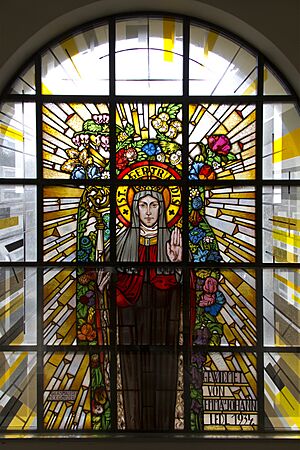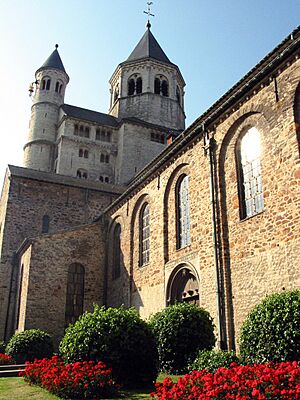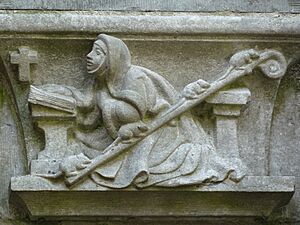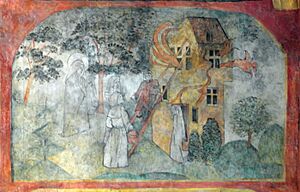Gertrude of Nivelles facts for kids
Quick facts for kids SaintGertrude of Nivelles OSB |
|
|---|---|
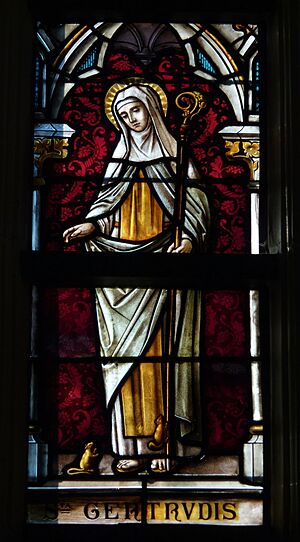
Stained glass window, Basilica of Our Lady in Tongeren, Belgium
|
|
| Virgin | |
| Born | c. 628 Landen, Kingdom of Austrasia |
| Died | 17 March 659 (aged 30–31) Nivelles, Kingdom of Austrasia |
| Honored in | Catholic Church, Eastern Orthodox Church |
| Canonized | 1677 by Pope Clement XII |
| Major shrine | Collegiate Church of Saint Gertrude, Nivelles, Walloon Brabant, Belgium |
| Feast | 17 March |
| Attributes | crosier, rats, mice and cats |
| Patronage | Geertruidenberg, gardeners, pilgrims, poor people, widows, cats, against rats, mice and pestilence |
Gertrude of Nivelles (born around 628 – died March 17, 659) was a special leader in the 600s. With her mother, Itta, she started the Abbey of Nivelles, which is now in Belgium. An abbess is the head of a community of nuns.
Contents
Life of Saint Gertrude
Her Family and Early Years
Gertrude's family history is not fully known, but they were very important. Her father, Pepin of Landen, was a powerful nobleman. He helped King Clothar II make his son, Dagobert I, the King of Austrasia.
Because of her family's high position, Gertrude grew up in the royal court. This meant she learned about politics and important decisions from a young age.
A Marriage Proposal
When Gertrude was ten, her father held a big dinner. The King himself came, which showed how important Gertrude's family was. At this dinner, the King asked Gertrude if she would marry the son of another powerful duke. This marriage would have helped her family gain more power.
But Gertrude said no! She told them she would not marry him or any earthly husband. She said she wanted to serve only "Christ the Lord." This was a very unusual thing for a girl to do back then. Marriages were often arranged to help families gain land and power.
After King Dagobert died, Gertrude's father, Pippin, also passed away around 640. This gave Gertrude the freedom to choose a religious life.
After Her Father's Death
To make sure Gertrude could follow her religious path, her mother, Itta, took a special step. She cut Gertrude's hair in a crown shape. This was a sign that Gertrude was dedicating her life to God.
Many people still wanted to marry Gertrude because her family was so rich and powerful. To stop these constant requests, Itta decided to build a monastery. A monastery is a place where monks or nuns live and worship. This new place, the Abbey of Nivelles, allowed Gertrude and her mother to live a religious life.
Starting the Monastery
In Gertrude's time, Christianity was not yet common everywhere. Monasteries like the one Itta and Gertrude founded helped spread the Christian faith.
Gertrude's story tells us that a bishop named Amand visited Itta's home. He suggested that Itta build a monastery for herself and Gertrude. So, Itta founded Nivelles, which was a "double monastery." This meant it had one part for men and another for women.
When Itta died around 652, Gertrude took over as the leader of the monastery. She managed everything, even though she was still quite young.
Life in the Monastery
Gertrude was known for being very kind, wise, and charitable. She helped the sick, the elderly, and the poor. She also knew many parts of the Bible by heart. She built churches and cared for orphans, widows, prisoners, and travelers.
As abbess, Gertrude sent people to Rome to get holy items and religious books. She also brought in experienced teachers from other countries, like Britain and Ireland. These teachers helped her and the other nuns learn more about God's laws and religious songs.
She welcomed many visitors, especially Irish monks who traveled to share their faith. Two such monks, Foillan and Ultan, visited Nivelles on their way to another monastery.
The Death of Foillan
There is a story about Foillan, one of the Irish monks. He had traveled to Francia to escape attacks in his homeland. He and his companions were welcomed by Gertrude and her family.
Later, Foillan went on a journey after saying mass at Nivelles. Sadly, he and three friends were betrayed and murdered by a man who offered them shelter. Gertrude helped find Foillan's body 77 days later.
Miracles of Saint Gertrude
A Heavenly Vision
One miracle happened when Gertrude was praying. She saw a bright, flaming ball of light come down. It lit up the whole church. This vision lasted for about half an hour and was seen by some of the other nuns. People believed it was a visit from "the True Light."
Saving Sailors
Another miracle happened when the writer of Gertrude's story and a friend were sailing. A terrible storm suddenly appeared, and a sea monster showed up! The sailors were very scared. In their fear, Gertrude's friend cried out to her for help. Right away, the storm stopped, and the monster went back into the deep water. This story made Gertrude known as a patron saint of travelers.
Her Final Days

Gertrude lived a very devoted life. She spent her time praying, fasting, and helping others. She became very tired from all her good work.
Before she died, Gertrude chose her niece, Wulfetrud, to be the next abbess of Nivelles. Wulfetrud was only 20 years old.
Gertrude felt her death was near. She asked a traveler from another monastery when she would die. This traveler, believed to be Ultan (Foillan's brother), told her she would die the very next day, March 17. He also said that Saint Patrick and angels would be ready to welcome her.
True to the prophecy, Gertrude died on March 17, 659, at the age of 33. She had prayed all night and received communion. After she passed away, a sweet smell filled her room.
Before her death, Gertrude asked to be buried simply. She wanted to be wrapped in an old veil left by a traveler and her own hair shirt (a rough cloth worn for religious reasons). She died in poverty, showing her humility. Her simple burial clothes became important holy items for the monastery.
Honoring Saint Gertrude
Saint Gertrude is the patron saint of the city of Nivelles in Belgium. Other towns like Geertruidenberg also honor her. She was also the patron saint of a religious group called the Crosiers. In a church in Maastricht, Netherlands, there is a large painting from the 1500s that shows eight scenes from her life.
Because of the story where she saved the sailors, Gertrude is also known as the patron saint of travelers. In the past, travelers would drink a special drink called "Sinte Geerts Minne" before starting their journeys. People also ask for her help with gardening and against rats and mice.
"Le Tour Sainte-Gertrude" is a traditional procession in Nivelles. People walk around the town, some in costumes, with a cart carrying a special container that holds Gertrude's holy items. This tour is considered an important cultural heritage event. A school in Nivelles, "Collège Sainte-Gertrude de Nivelles," is also named after her.
Saint Gertrude in Old Writings

The main story about Gertrude's life is called Vita Sanctae Geretrudis. It was written very close to the time she lived, probably before 670. This makes it a very important source for understanding history in the 600s. The person who wrote it seems to have seen many of the events firsthand.
The Vita was written for the abbess who took over after Gertrude's niece, Wulfetrud, died.

Historians believe the Vita is mostly true because it was written so soon after Gertrude's life. It would have needed to seem believable to people living at that time.
Family Tree
| Pepin of Landen (c. 580–640) |
Itta of Metz (592–652) |
Saint Modoald (c. 585 – 645 or 648) |
Severa (c. 600 – c. 640) |
Unknown |
|||||||||||||||||||||||||||||||||||||||||||||||
| Grimoald the Elder (616–657) |
Gertrude of Nivelles (c. 628–659) |
Begga (613–693) |
Modesta († c. 660) |
||||||||||||||||||||||||||||||||||||||||||||||||
| Pepin of Herstal (635–714) |
|||||||||||||||||||||||||||||||||||||||||||||||||||
| Charles Martel (c. 690–741) |
|||||||||||||||||||||||||||||||||||||||||||||||||||
| Pepin the Short (714–768) |
|||||||||||||||||||||||||||||||||||||||||||||||||||
| Charlemagne (747–814) |
|||||||||||||||||||||||||||||||||||||||||||||||||||
See also
 In Spanish: Gertrudis de Nivelles para niños
In Spanish: Gertrudis de Nivelles para niños


